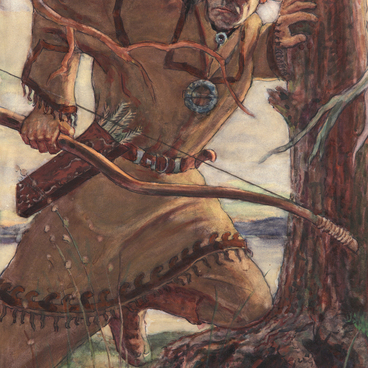Andrey Andreyevich Shelkovnikov, a set designer and Honored Artist of the RSFSR, worked as a chief artist of the Musical Theater of Karelia from 1958 to 1981. In 1987, he also joined the Omsk Musical Theater as an artist.
In 1986, Andrey Shelkovnikov was awarded the Glinka State Prize of the RSFSR for his contribution to the new production of the ballet “The Sampo”, staged at the Musical Theater of the Karelian ASSR. Music for the ballet was composed by Helmer-Rainer Sinisalo.
Pohyola is a mysterious northern country. Literally, this word means “the land of frost and disease”. In songs, it is portrayed as a hostile place, but also as a place where the heroes go to court women. Historically, men were supposed to marry women from other families to prevent inbreeding. Pohyola is associated with Lapland. Its inhabitants are believed to be skilled in magic. In fact, many different peoples considered Laplanders as skilled sorcerers.
Elias Lönnrot, the compiler of the epic poem “Kalevala”, presents Pohyola as the primary antagonist to the land of Kalevala, where the central characters reside. These characters frequently travel between Kalevala and Pohyola for various objectives. Each journey is described in a distinct manner. In order to create the image of Pohyola, Lönnrot relied on folk poetry, legends and incantations that describe various mythological places. Hence, in the poem “Kalevala”, Pohyola is a composite image based on different mythical territories such as Pohjola, Pyävelä, Hiihtola, and Tapiola, etc. At the same time, Lönnrot chose not to incorporate numerous other areas mentioned in folk poems.
It is in Pohyola where many significant events occur. Brides are courted there. An endless source of flour, salt, wealth and various benefits, albeit short-termed, — the magical Sampo — is forged there. The heroes even undertake a sea voyage to capture the Sampo in Pohyola.
According to the runes, one
can reach Pohyola by sea (drifting through open waters by boat), by land
(mounted on an animal or by sled), and by air (in a “wind boat”). The most
common method of reaching Pohyola involves crossing a body of water,
interpreted as the traditional boundary between this world and that world.



